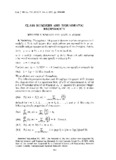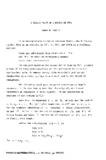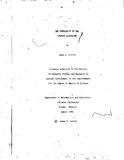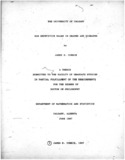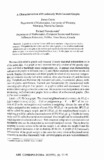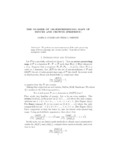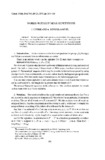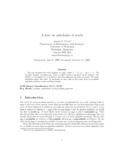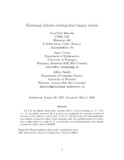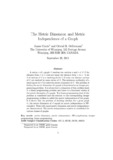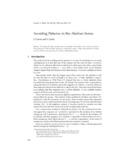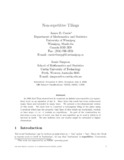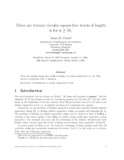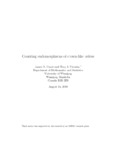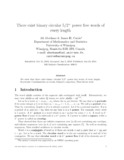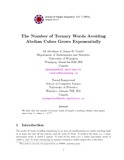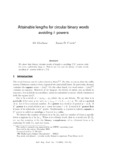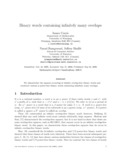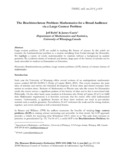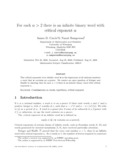Parcourir James D. Currie par date de publication
Voici les éléments 1-20 de 39
-
Class Numbers and Biquadratic Reciprocity
(Cambridge University Press, 1982) -
A direct proof of a result of Thue
(Utilitas Mathematica, 1984) -
The Complexity of the Simplex Algorithm
(Carleton UniversityCarleton University, 1984-08)The thesis begins by giving background in linear programming and Simplex methods. Topics covered include the duality theorem, Lemke's algorithm, and the pathological programs of Klee-Minty. Because of the bad behaviour ... -
Non repetitive walks in graphs and digraphs
(The University of CalgaryUniversity of Calgary, 1987-06)A word $w$ over alphabet $\Sigma$ is {\em non-repetitive} if we cannot write $w=abbc$, $a,b,c\in\Sigma^*$, $b\ne\epsilon$. That is, no subword of $w$ appears twice in a row in $w$. In 1906, Axel Thue, the Norwegian number ... -
A Characterization of Fractionally Well-Covered Graphs
(Ars Combinatoria, 1991)A graph is called well-covered if every maximal independent set has the same size. One generalization of independent sets in graphs is that of a fractional cover -- attach nonnegative weights to the vertices and require ... -
The number of order–preserving maps of fences and crowns
(Springer, 1991-06)We perform an exact enumeration of the order-preserving maps of fences (zig-zags) and crowns (cycles). From this we derive asymptotic results. -
Words without Near-Repetitions
(Canadian Mathematical Society, 1992-06-01)We find an infinite word w on four symbols with the following property: Two occurrences of any block in w must be separated by more than the length of the block. That is, in any subword of w of the form xyx, the length of ... -
A Note on Antichains of Words
(The Electronic Journal of Combinatorics, 1995-10-14)We can compress the word 'banana' as xyyz, where x= 'b', y= 'an',z= 'a'. We say that 'banana' encounters yy. Thus a 'coded' version of yy shows up in 'banana'. The relation 'u encounters w' is transitive, and thus generates ... -
Extremal Infinite Overlap-Free Binary Words
(The Electronic Journal of Combinatorics, 1998-05-03)Let t be the infinite fixed point, starting with 1, of the morphism μ:0→01, 1→10. An infinite word over {0,1} is said to be overlap-free if it contains no factor of the form axaxa, where a∈{0,1} and x∈{0,1}∗. We prove that ... -
The metric dimension and metric independence of a graph
(The Charles Babbage Research Centre, 2001)A vertex x of a graph G resolves two vertices u and v of G if the distance from x to u does not equal the distance from x to v. A set S of vertices of G is a resolving set for G if every two distinct vertices of G are ... -
Avoiding Patterns in the Abelian Sense
(Canadian Mathematical Society, 2001-08)We classify all 3 letter patterns that are avoidable in the abelian sense. A short list of four letter patterns for which abelian avoidance is undecided is given. Using a generalization of Zimin words we deduce some ... -
Non-Repetitive Tilings
(The Electronic Journal of Combinatorics, 2002-07-03)In 1906 Axel Thue showed how to construct an infinite non-repetitive (or square-free) word on an alphabet of size 3. Since then this result has been rediscovered many times and extended in many ways. We present a two-dimensional ... -
There are Ternary Circular Square-Free Words of Length n for n ≥ 18
(The Electronic Journal of Combinatorics, 2002-10-11)There are circular square-free words of length n on three symbols for n≥18. This proves a conjecture of R. J. Simpson. -
Counting endomorphisms of crown-like orders
(Springer, 2002-12)The authors introduce the notion of crown-like orders and introduce powerful tools for counting the endomorphisms of orders of this type. -
There Exist Binary Circular 5/2+ Power Free Words of Every Length
(The Electronic Journal of Combinatorics, 2004-01-23)We show that there exist binary circular 5/2+ power free words of every length. -
The Number of Ternary Words Avoiding Abelian Cubes Grows Exponentially
(2004-06-19)We show that the number of ternary words of length n avoiding abelian cubes grows faster than r^n, where r = 2^{1/24} -
Attainable lengths for circular binary words avoiding k-powers
(The Belgian Mathematical Society, 2005)We show that binary circular words of length n avoiding 7/3+ powers exist for every sufficiently large n. This is not the case for binary circular words avoiding k+ powers with k < 7/3 -
Binary Words Containing Infinitely Many Overlaps
(The Electronic Journal of Combinatorics, 2006-09-22)We characterize the squares occurring in infinite overlap-free binary words and construct various α power-free binary words containing infinitely many overlaps. -
The Brachistochrone Problem: Mathematics for a Broad Audience via a Large Context Problem
(Montana Council of Teachers of Mathematics & Information Age Publishing, 2008)Large context problems (LCP) are useful in teaching the history of science. In this article we consider the brachistochrone problem in a context stretching from Euclid through the Bernoullis. We highlight a variety of ... -
For each a > 2 there is an Infinite Binary Word with Critical Exponent a
(The Electronic Journal of Combinatorics, 2008-08-31)The critical exponent of an infinite word w is the supremum of all rational numbers α such that w contains an α-power. We resolve an open question of Krieger and Shallit by showing that for each α>2 there is an infinite ...

